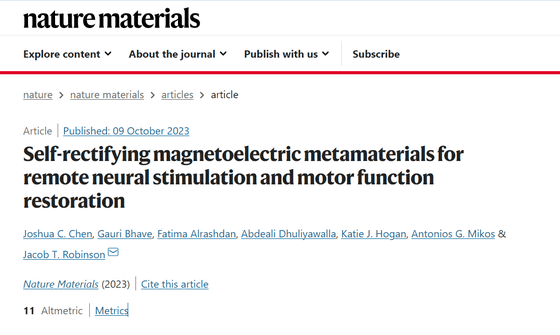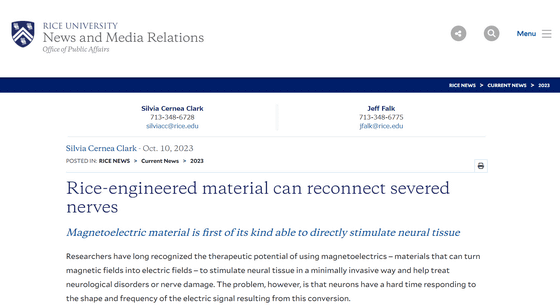Succeeded in developing a substance that can reconnect severed nerves

Human nerve cells exchange various information by transmitting electrical signals via ions that exist inside and outside of their membranes. However, once these nerve cells are damaged and cut off, it is extremely difficult to reconnect them. A research team at Rice University has reported that they have succeeded in an experiment to reconnect damaged nerve cells using a newly discovered material.
Self-rectifying magnetoelectric metamaterials for remote neural stimulation and motor function restoration | Nature Materials
https://www.nature.com/articles/s41563-023-01680-4

Rice-engineered material can reconnect severed nerves | Rice News | News and Media Relations | Rice University
https://news.rice.edu/news/2023/rice-engineered-material-can-reconnect-severed-nerves

A team led by Rice University neuroengineer Jacob Robinson has developed a ``self-rectifying magnetoelectric metamaterial'' that can convert magnetism to electricity 120 times faster than conventional methods. This self-rectifying magnetoelectric metamaterial has a structure in which a substance called lead zirconate titanate is sandwiched between two metallic glass alloys, and can convert magnetism into electricity.

Joshua Chen, a member of the research team and the paper's lead author, said: ``We're trying to create a dust-like substance, or a very small substance that can be sprinkled inside the body to stimulate the brain and nervous system.'' I thought, 'Is it possible?'' he says.
However, the electrical signals generated by this self-rectifying magnetoelectric metamaterial were too fast for neurons to detect, and the signal pattern was too uniform. So the researchers stacked platinum, hafnium oxide, zinc oxide, and a self-rectifying magnetoelectric metamaterial thinly to create a thin layered material just less than 200 nanometers wide, making it suitable for electrical activity in nerve cells. .
The research team has reported that by administering the developed laminated material to rats with peripheral nerve damage and stimulating the nerves, they were able to restore the function of the damaged nerves. This report shows the possibility of creating a nerve brace that can reconnect severed nerves.

'Using this metamaterial, we can fill the gaps in damaged nerves and restore the speed of electrical signals,' Chen said. 'More importantly, this advanced materials design framework can be applied to other applications such as sensing and memory in electronics.'
'It's really exciting to be able to design devices and systems using materials that didn't exist before, rather than being limited to materials that exist in nature,' said Robinson. 'It's really difficult to anticipate all the potential applications. We focused on bioengineering, but there are also great potential applications in other fields.'
Related Posts:
in Science, Posted by log1i_yk







